2018 News Archive
Recording, conserving and promoting the landscape and rocks of the Sheffield region
SAGT News Archive 2018
Wadsley Fossil Forest - installation 12 October 2018
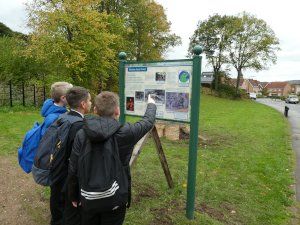
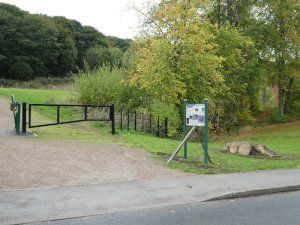
The fossil tree stumps were described by Henry Clifton Sorby in the 1870s, when the former Middlewood Hospital was being built. They were re-examined in recent years and a latex mould was taken of the best example, before they were covered up again to protect them. The board is accompanied by a cast from that mould and both were set up in pouring rain by a Sheffield Council contractor on 12th October 2018.
It was gratifying to find a group of youngsters studying the board, on their way home from school, before the concrete had even had time to go off!
Darnall RIGS - Second phase recording completed on 5 October 2018
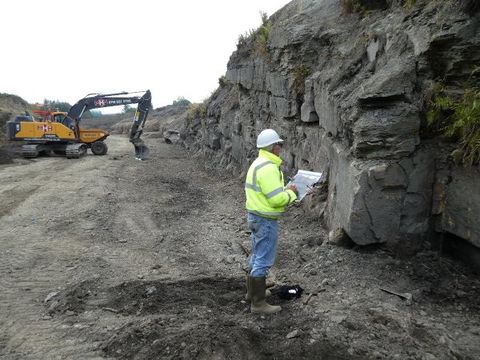
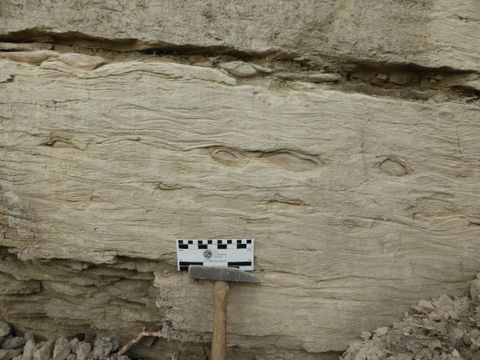
Details of the internal sedimentary structures of this Coal Measures fluvial sandstone body have been recorded on the panoramic photos printed as a sequence of overlapping tiles. The example included here shows flaser bedding in fine-grained sandstone. This texture was formed by migrating and climbing current-ripples on the bed of the river that deposited it. The next stage is to study the information obtained from the drilling of site-investigation boreholes to understand better the relationship between this sandstone unit and the Swallow Wood coal seam that underlies it.
Darnall RIGS - Second Phase photos taken on 30 September 2018
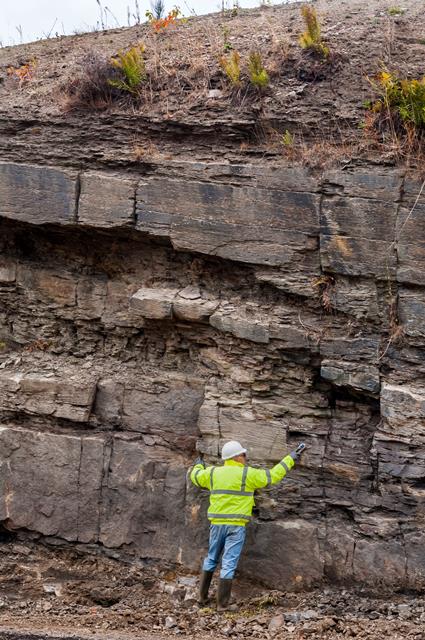
High resolution panoramic photography and geological mapping of one half of the old railway cutting has been completed by SAGT, enabling MHH Contracting Ltd to resume their normal operations in that part of the site. Panoramic photographs of the second half were taken today by Phil Wolstenholme after a final dust-off at one or two parts of the rock face.
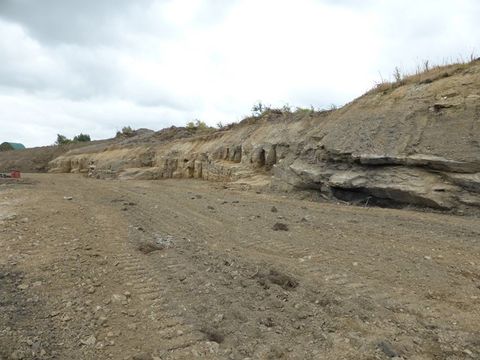
Rescue recording of a RIGS at Darnall - posted 25 September 2018

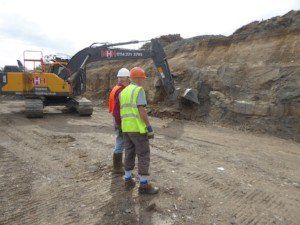
SAGT members (and friends!) are currently involved in a 'rescue' exercise to record the geology of a RIGS (Regionally Important Geological Site) before it disappears under housing. RIGS G300 consists of a 300 m long railway cutting off Ouseburn Road in Darnall, Sheffield. A Planning Condition obliged the contractor, MHH Contracting Ltd, to provide access whilst the site was being cleared of vegetation and slipped debris. An excellent relationship was established between SAGT and MHH, provided that our work did not hold up geotechnical investigations. Their highly skilled and enthusiastic digger driver, John, duly cleared surfaces, followed by us with shovels and brushes to expose the detail. The geology is being recorded directly onto high resolution photographs.
University Research Projects - posted 25 July 2018
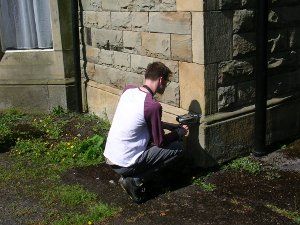
Chelsea Court
SAGT continues to liaise with the Universities of Derby and Keele as they supervise their students' research projects in our region. An MSc student from Keele has made three visits to the Sheffield area to test building stones, both in quarries and on buildings, using a hand-held XRF meter, to see if the proportions of trace elements in the rocks are characteristic of each named sandstone unit. If so, it may be possible to find the parent quarry for some of our major sandstones, and also to suggest the provenance of each sand body when it was deposited in the Upper Carboniferous Period.
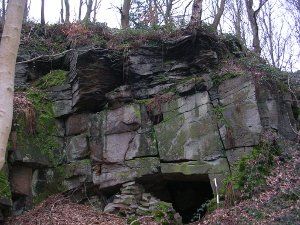
Delf Hill
The Second Year Derby student is carrying out fieldwork for his dissertation for his BSc degree,
focussing on the Rough Rock sandstones at Whirlow in S11, Brown Edge at Ringinglow and at Delf Hill near Wharncliffe Side. There is much variation between these three sites and we hope that he will be able to report some fresh interpretations of the geology.
Geology Walks for GeoWeek - May 12th & 13th 2018 - Report

Which way is up? (St Paul's Parade)
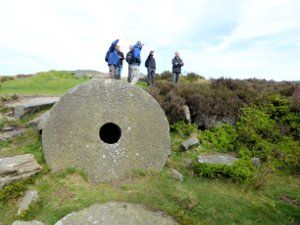
So where did they quarry this millstone from?
SAGT planned two "field" visits for the new national venture, Geoweek 2018. A geological walkabout was arranged for 12th May, to look at the building stones in Sheffield City Centre and to try to elucidate the story of Britain's position on the globe in the past. On the day, only two visitors turned up - a 6th Form Geology student and her mum, although we also got some funny looks from passers-by. The student said that the tour gave very useful revision for 'A Level', and soon found herself deciding which blocks of stone had been inserted into the buildings the wrong way up, using evidence such as cross-bedding. Her mum, an ecologist, accepted that the geology controls what grows or lives on top of it, and also found the morning of value. The alabaster tombstone of the Earl of Shaftesbury, outside the back of the Cathedral, should be examined for more and more growing on top of it as it rapidly weathers!
The second excursion, to the southern end of the Burbage Valley on 13th, was attended by 6 people, in glorious sunshine. Clambering over the fallen blocks of gritstone on the way up to the two deep quarries on the eastern edge of the valley revealed a wide range of features, ranging from sedimentary structures and possible plant imprint fossils, to the results of man-made activity. As might be expected, there were the marks of quarrying, including drill holes for the "plug and feathers" technique of splitting blocks and some amazing lines of chisel marks where somebody optimistically had begun to mark out the division of an absolutely huge mass of gritstone. Many of the blocks were pock-marked by bullet holes or mortar blasts from WW2 when the valley was used for live-firing training. The group discussed the evidence of periglacial processes and searched (in vain) for marine fossils in the shales next to the river, so had to be content with "one we found here before" from the leader's rucksack!
So, two enjoyable trips, but we need to widen the publicity if we do this again next year.
Don Gorge Walk - 11 May 2018
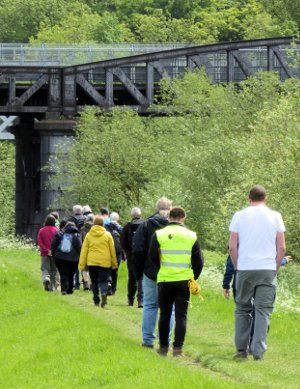
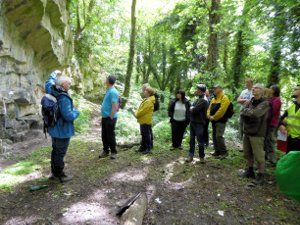
SAGT has again linked up with the Don Catchment Rivers Trust for a second year, to guide a geology and landscape walk through the Don Gorge. Twenty intrepid walkers turned up, and the weather and the gorge did not disappoint. Over three hours we rambled at a steady pace for about three kilometres along the gorge looking at the Permian limestones, the landscape development and drainage of the area, finishing up with a stroll down to the limekilns, and the site of the old Levit Haag village. As ever, the local knowledge of the participants, some of whom remembered the village, contributed a great deal to the event.
Sandstone data & visit to Sheffield - 8 May 2018

An MSc student, Keegan Burrows and his tutor, Dr Ralf Halama, from Keele University, carried out an initial survey into some of the building stones of the Sheffield region on 8th May. They are using an XRF technique which enables rapid measurements to be made of the ratios between the elements which make up the minerals in the rock. It is hoped that this might throw some light on the source areas from which the sediments were derived during the Carboniferous Period. It may also be possible to define which major sandstone units have provided some of our local building stones - in most cases the documentary evidence for their origins has been lost.
The photo shows Keegan using the XRF gear on an exposure of the Greenmoor Rock, which was formerly of great importance as a building stone and a source of grindstones, and is still worked near Huddersfield.
Yorkshire Geology Day - 21 April 2018
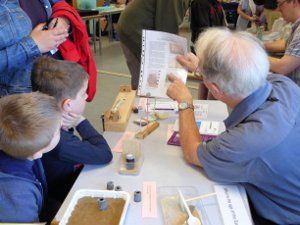
SAGT took part in the Yorkshire Geology Day celebrations at Caphouse Mining Museum on April 21st. Mums & Dads brought their children (and their rock and fossil collections to be identified) and met Geology Trust members from across Yorkshire.
There were geo-activities, experiments to get children thinking, lots of useful ideas for day trips out to see rock places, as well as guided underground trips, lots to see in the museum, and even fossil biscuits. Make a note in your diary for 2019: the second Saturday in April (13th) and come along.
Sheffield: the city that rocks (posted 13 April 2018)
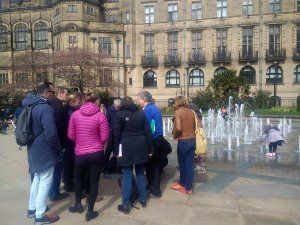
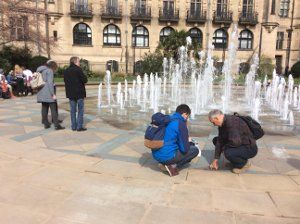
Geography teachers attending the 2018 Geographical Association conference, held in Sheffield, used the SAGT Sheffield Building Stones Trail to discuss how to use rocks in town centres for pupils to see examples of a variety of rocks and learn about different rock types, their properties and how they link in the rock cycle. They even worked out how you can see evidence of plate tectonics in the rocks of Sheffield town centre.
Led by SAGT member Duncan Hawley (in blue in first photo), the teachers went on a field walk from the Peace Gardens down Fargate to Campo Lane at the back of the Cathedral where they were tasked with finding examples of igneous, sedimentary, metamorphic and fake rocks, finally ending with excellent examples of stone weathering - "flaking", "scaling" and "granular disintegration" - caused by repeated wetting and drying of the stone leading to growth of salt crystals just under the surface that lever the rock apart.
Charter Square (posted 2 March 2018)
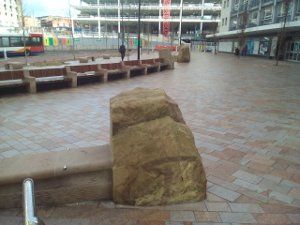
Charter Square - general view of the new stonework
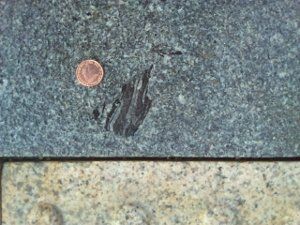
A highly metamorphosed xenolith in the dark Chinese "granite". The 1p coin is 2 cm in diameter
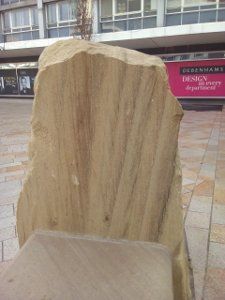
A cross-bedded sandstone from Hall Dale Quarry
Sheffield Council's Landscape Architects have continued their thoughtful use of natural stone with the new work being installed in Charter Square. The general view shows the paving in a range of pale-coloured Chinese granites, the bench seats and one of the sandstone "monoliths". These large blocks are of Namurian age and come from the Hall Dale Quarry, near Darley Dale, and some show cross-bedding and ironstone nodules. The seats are made from pink and buff Stanton Moor Sandstone, with the legs of Stoke Hall Sandstone from Grindleford. A dark "granite" from China is used for the kerbstones and many of these display superb xenoliths of older rock fragments, highly metamorphosed by the heat of the granitic magma. Some slabs have huge white feldspar crystals, which cooled from the magma at a slower rate than the rest of the rock and so had more time in which to crystallise. Further work is planned in Charter Square, so keep your eyes peeled!
Match it! (posted 1 January 2018)
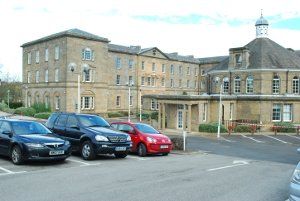
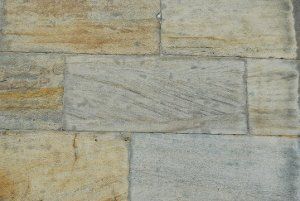
SAGT is endeavouring to match some well-known Sheffield buildings to the sources of their building stone. Here is one in which we are confident, where fieldwork and archive research have come together.
The former Sheffield Royal Infirmary, 1793, was built from sandstones of the Loxley Edge Rock. Small quarries and worked blocks of stone occur in the woodland below the scarp face of Loxley Edge (at Grid Ref SK3105 9058, purple scale bar is 25cm).
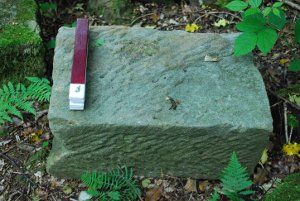
Best minor fold? (posted 1 January 2018)

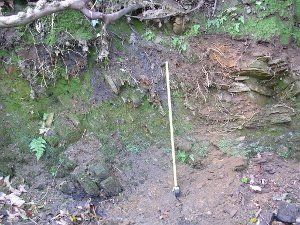
Is this the best minor fold in Sheffield? (About 100m downstream of Forge Dam at Grid Ref SK305850). The tape shows one metre. The fold axis runs roughly parallel to the trend of the valley of the Porter Brook, so could the fold be the result of earth movements or "valley bulging"? Discuss!
email: sageologytrust@gmail.com
Copyright: Sheffield Area Geology Trust. Registered Charity No. 1133465, England
